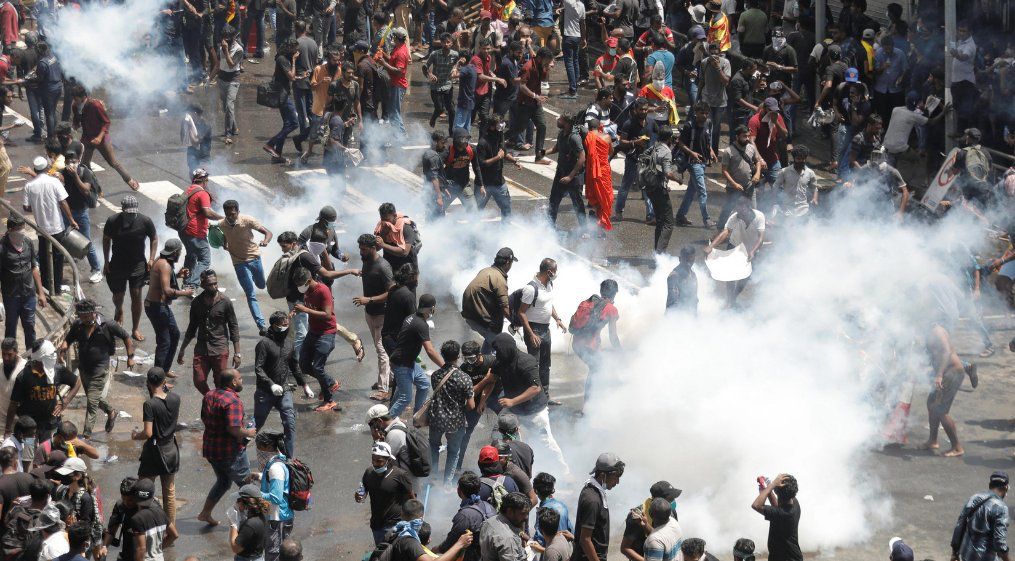
Sri Lanka’s worst economic crisis has given way to a mass anti-government movement. The movement often referred to as Aragalaya - the Sinhala word for “struggle” - started off vehemently demanding the resignation of Gotabaya Rajapaksa for his role in
destroying the island’s economy. After protesters stormed his residence, Rajapaksa fled to Singapore where he formally announced his resignation. Upon receiving the news, protesters gathered outside the presidential secretariat to celebrate the ousting of a president they once held as a saviour.
The Aragalaya has overwhelmingly been characterized as a revolutionary movement that has unified Sri Lanka across ethnic and religious boundaries. However, this perceived unity is superficial at best. Indeed, despite repeated Tamil frustrations being aired, it has become clear that the voice of the Aragalaya is the voice of the Sinhalese people and its demands are concerned with the Sinhalese experience. To make the claim that there is unity in this movement is to once again repeat the cycle of Sinhala Buddhist nationalism that has dominated the island.
The experience of political life in Sri Lanka is tied to the ethnic character of the state. The Sri Lankan state is a Sinhala Buddhist bastion and exists to serve the interests of the Sinhalese numerical majority. It is a state that has systematically oppressed its Tamil and Muslim peoples. From the Sinhala Only Act of 1956 to the ‘One Country One Law’ task force led by an anti-muslim extremist monk, it is clear that an elevated status of privileged citizenship belongs primarily to the Sinhalese. To characterize the recent protests as unifying is to erase the voices of Tamils and Muslims on the island and to assume the experience in Sri Lanka is homogenous. These are communities that have been demanding structural change for countless years, but their demands are not considerations for the Aragalaya.
Whilst protests engulfed the South, the Tamil North-East remained relatively quiet. This is true for several reasons. The North-East is heavily militarized, a process that has assisted in the repression of peaceful protests and the surveillance of Tamils. Furthermore, there is scepticism amongst Tamils that the Aragalaya will bring about the necessary structural change. Tamil civil society has very clearly articulated what is needed from the Sri Lankan state for decades. These demands have been reiterated numerous times amidst the protests which have been taking place in the South. Some of these demands include accountability for war crimes and genocide, devolution of powers, answers for the thousands of forcibly disappeared Tamils, the ceasing of land acquisitions, and the repealing of the Prevention of Terrorism Act. Numerous Tamil activists and organizations have emphasized that the current political crisis should be used “to confront Sinhala Buddhist nationalism and address the legitimate Tamil grievances.” Despite these calls to action, the Aragalaya seems primarily concerned not with a restructuring of the state but simply a regime change.
Tamils both in the homeland and around the world have repeatedly called for Gotabaya Rajapaksa to be put on trial for the war crimes and atrocities committed in the final phase of armed conflict. At every opportunity the Tamil population voted against Rajapaksa. Rajapaksa came to power on a platform of Sinhala Buddhist nationalism and despite being a credibly accused war criminal he found overwhelming support amongst the Sinhalese population. The recent shift in attitude against Rajapaksa was not due to his war crimes or his divisive policies, rather it was the result of the economic crisis. Even after having fled the country and resigning, there have been remarkably few calls from Sri Lanka’s protestors calling for him to face justice. Instead, international human rights groups and Tamil organisations have repeated calls for accountability.
This stark contrast can be traced back to the experiences of the Sinhalese and the Tamils in Sri Lanka, which in turn informs the difference in their demands. For many in Aragalaya the goal is ousting Rajapaksa and his allies. For Tamils there will be no peace until the figures responsible for mass atrocities face justice and the entire structure of the island is remodelled.
Mass mobilization in Sri Lanka cannot be isolated from the context of the deep-rooted Sinhalese Buddhist nationalism in the State. In claiming that the Southern protest movement has unified the island, the voices of Tamils and Muslims are swallowed once again by the roar of the Sinhalese majority. This moment in Sri Lankan history has the potential to be revolutionary, but only through a radical restructuring of the state. It necessitates that the voices of communities that have long been silenced are heard. With newly appointed Ranil Wickremesinghe heading a crackdown in the South, Aragalaya’s protestors are experiencing directly why many Tamils have demanded change go deeper than the figureheads at the top of a rotten state structure. The rest of the South must now listen.
___
Asvini is a writer at the Tamil Guardian.
We need your support
Sri Lanka is one of the most dangerous places in the world to be a journalist. Tamil journalists are particularly at threat, with at least 41 media workers known to have been killed by the Sri Lankan state or its paramilitaries during and after the armed conflict.
Despite the risks, our team on the ground remain committed to providing detailed and accurate reporting of developments in the Tamil homeland, across the island and around the world, as well as providing expert analysis and insight from the Tamil point of view
We need your support in keeping our journalism going. Support our work today.
For more ways to donate visit https://donate.tamilguardian.com.

